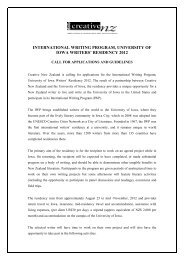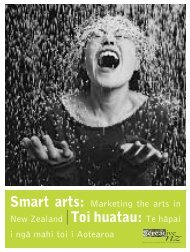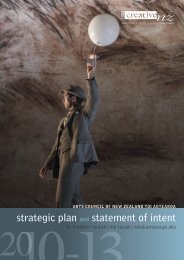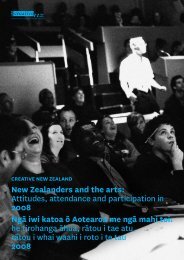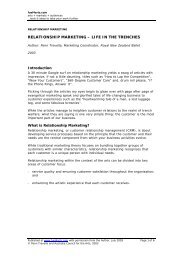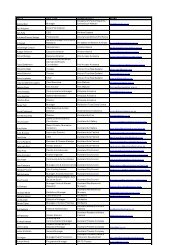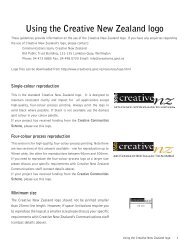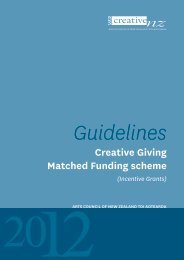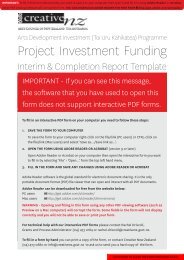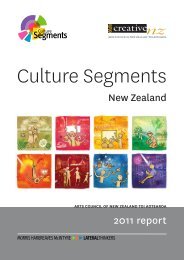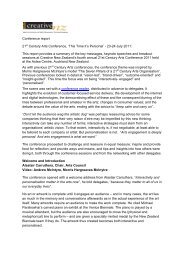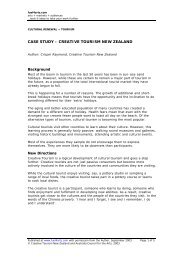FULL HOUSE Turning Data into Audiences - Creative New Zealand
FULL HOUSE Turning Data into Audiences - Creative New Zealand
FULL HOUSE Turning Data into Audiences - Creative New Zealand
Create successful ePaper yourself
Turn your PDF publications into a flip-book with our unique Google optimized e-Paper software.
Unrealistic perhaps, but the spirit of what is required is in<br />
that idea. However, the biggest challenge is not in that first<br />
visit, because all the evidence points to the challenge of<br />
bringing them back for a return visit.<br />
3. Returning<br />
For new attenders, some organisations follow up the<br />
next day (if not that night) with a ‘morning after’ email or<br />
direct communication which proposes further events in<br />
the programme and possibly an incentive to return. For<br />
those attenders who don’t respond, many venues say<br />
that whenever an event occurs which matches their first<br />
attendance, a simple direct communication can trigger a<br />
high response.<br />
4. Nurturing<br />
Developing frequency of attendance does require some<br />
understanding of the attenders and their life-stage and<br />
circumstances. How frequently is it realistic to expect<br />
people to attend? If 85% of attenders actually attend<br />
infrequently, why assume everyone is a prospective<br />
frequent attender. Success could be in achieving just two<br />
or three attendances per annum. This requires sensitivity<br />
and not bombardment with direct communication. Other<br />
media than direct marketing, such as newsletters and<br />
magazines, can be an effective method of communicating<br />
with people without the hard sell and can provide a<br />
rounded view of the organisation and its activities,<br />
so people can respond as they wish. Importantly,<br />
communication needs to be differentiated, and with<br />
different messages for the most frequent attenders from<br />
those sent to the relatively new attenders. These people<br />
may still feel they are ‘outsiders’, not understanding<br />
the jargon and terminology that is the norm for the<br />
keen advocate.<br />
5. Focussing<br />
What do we want from the attenders on our database<br />
as we develop the relationship with them? Some<br />
organisations want to use subscription schemes to recruit<br />
people to relatively frequent attendance, usually heavily<br />
incentivised with discounts and other added-value offers.<br />
This can be effective in converting some attenders <strong>into</strong><br />
frequent attenders. Some marketers say they are creating<br />
a ‘walled garden’ in which their attenders can be safely<br />
communicated with and promoted to, being treated with<br />
respect as knowing ‘insiders’. Can we focus this by inviting<br />
them to join a Friends or membership scheme? Liz Hill<br />
and Brian Whitehead, publishers of Arts Professional, point<br />
out in their book The Complete Membership Handbook 13<br />
that there could be more than 12 different concepts for<br />
such schemes. In terms of ‘loyalty’, the most successful<br />
schemes are run by the organisation itself, firmly focussed<br />
on attendance and participation, and offering clear and<br />
tangible benefits to people who consciously choose to<br />
participate. Understand that schemes can be multi-level,<br />
so members are segmented according to the membership<br />
level they choose, and hence will need separate tailored<br />
communications.<br />
6. Supporting<br />
Importantly, at this stage the support is two-way. The<br />
attenders should be supporting the efforts of the<br />
organisation, through advocacy, acting as ambassadors,<br />
volunteering, making donations and helping with fundraising.<br />
And the organisation needs to support the<br />
attenders so they understand the messages and what they<br />
can do to help. Again this could require multiple levels<br />
according to what activity people are willing to engage in<br />
and the level of commitment they are comfortable with.<br />
13. Liz Hill and Brian Whitehead, The Complete Membership<br />
Handbook, 2004, Directory of Social Change in association with<br />
Arts Professional<br />
24 <strong>FULL</strong> <strong>HOUSE</strong>: <strong>Turning</strong> <strong>Data</strong> <strong>into</strong> <strong>Audiences</strong> © Roger Tomlinson & Tim Roberts



